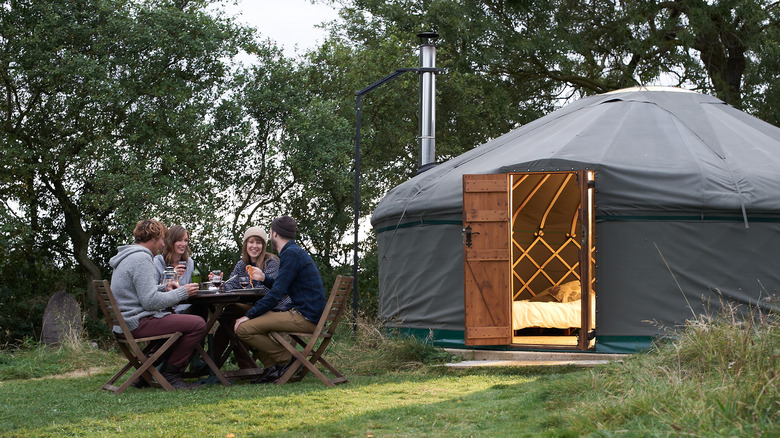The One Big Difference Between A Yurt And A Tent
Yurts and tents, though both designed to provide portable shelter, have distinct origins and serve different purposes. Yurts, historically used by nomadic cultures in Central Asia — especially in Mongolia — have been around for over 3,000 years. These circular structures, built with a wooden frame covered in felt or fabric, were designed to endure extreme weather conditions while still being portable. As such, yurts served as living solutions for nomadic families, who moved their herds seasonally in search of better grazing land.
Tents, on the other hand, have been used across many different cultures globally, from early civilizations to modern-day campers. Lighter and more compact, tents are typically made from materials like nylon or canvas, and supported by flexible poles. Tents are a popular choice as they are easy to carry and setting them up, whether camping or otherwise, is pretty simple as well. Their simplicity and lightness make them ideal for those on the move. While yurts and tents share some similarities and some differences, one major distinction sets them apart: longevity.
Yurts are more durable and long-lasting than tents
Yurts are significantly sturdier than tents, thanks to their wooden frame and circular design. Coupled with their thick walls made with layers of fabrics, they offer superior insulation and temperature control in both hot and cold environments. These design elements provide excellent stability against heavy winds, rain, and even snow, making them more durable and ideal for semi-permanent setups. Yurts are also typically much bigger than tents. This is because most nomadic groups would do almost everything from cooking to entertaining within their yurts, necessitating a larger space. So, even though yurts were portable living solutions, they served as medium-to-long-term living solutions for nomadic groups.
In contrast, tents are designed to provide only short-term shelter. A tent's thin walls and simple pole structure are good for short-term camping trips, but even seasoned campers know that this is only true under ideal conditions. Tents lack the solid structure of a yurt, so they don't provide good protection from extremely harsh elements. They also don't necessarily stay warm, unless you reinforce your tent walls to do so. Plus, tents aren't designed to offer space for activities like cooking. Campers usually set up tents for a basic rest spot for a few nights before packing it up and heading home, or continuing on their adventure. As such, tents are meant for short-term, lightweight camping experiences, because they can't provide the same level of comfort for as long as a yurt.

